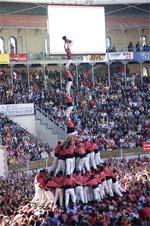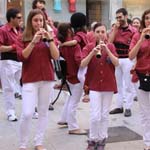Castells Contest
The word castell means castle in Catalan language. The Castells were declared by the UNESCO to be amongst the Masterpieces of the Oral and Intangible Heritage of Humanity.
 The origin of the Castells is commonly referenced to be associated with the so-called “Dance of the Valencianos”, an antique celebration that probably started around the XVIII century around religious processions, where people danced and built a human sculpture that later became independent, and gained a status of its own. The birthplace of this celebration is thought to be some in villages of the Ribera Alta, a region in the province of Valencia, but is nowadays associated with the whole Catalan world, that is, Catalonia, Valencia and the Balearic Islands, and to the popular celebrations of its towns and villages.
The origin of the Castells is commonly referenced to be associated with the so-called “Dance of the Valencianos”, an antique celebration that probably started around the XVIII century around religious processions, where people danced and built a human sculpture that later became independent, and gained a status of its own. The birthplace of this celebration is thought to be some in villages of the Ribera Alta, a region in the province of Valencia, but is nowadays associated with the whole Catalan world, that is, Catalonia, Valencia and the Balearic Islands, and to the popular celebrations of its towns and villages.
Later on, associated with the local festivities in Valls -a town in the province of Tarragona-, there is the first documented rivalry between two colles (groups) of castellers (the people that build the castell) in 1801. This can be considered the real origin of the Castell Contest as we see it today, and its expansive wave hit all surrounding villages, that hired the Valls’ colles to perform at their own festivities. Because of this seminal influence, Valls is considered to be the home town of the castell tradition.
With time, many other colles were found in many villages, and the rivalry grew bigger, what made the participant groups try to build more and more complex structures. The castellers have a common motto, tthough, which sums up their philosophy: “Strength, Equilibrium, Courage and Common Sense”.
Parts of the Castell
The castell is made up of many parts, each of them having a function in holding the structure together, and receive a name of their own:
- The pinya: it’s the base of the castell, and where the largest number of people is found, to give the castell a firm grounding. They form a shape of concentric circles held together through different shapes and formations, and the inner circle is also the starting point of the tower.
- The tronc: it is the visible part (plus the invisible central structure), and its structure and height determine the castell’s dificulty
- The Pom de dalt: the top part of the tower, which always has the same structure independently of the shape and structure of the rest of the castell. It consists of a level with two castellers called “dosos”, and the “acotxador”, who usually is the smallest member of the castell. The top is crowned by the “antxaneta”, usually a small kid. Once the “antxaneta” has climbed up, and stands on his feet with an arm in the air, the castell is considered to be completed.
- The folre: another circle of castellers that stands on top on the pinya, reinforcing the second and third levels of the castells in those of bigger difficulty.
- The manilles: the same as the folre but one level up, it is mainly used in castells that reach a greater height.
- The puntals: a group of castellers that stand on top of the manilles to secure the structure.

An important aspect of this event is the music that accompanies the building of the castell. It is played with a medieval style flute -called gralla- and timbales. The music starts once the base for the castell -that is, the pinya- is set, and the levels start rising up. A different music is played during the building up and when the castell is brought down.
The way the castellers dress is also part of the tradition: they wear a traditional costume, made up of a red shirt, white pants and a black fabric as a wide belt. The kids, and those castellers that go up higher are also obliged to wear a protective helmet since recent times, even though accidents are few and rarely mortal.
The Castell Contest
Being such an original, idiosyncratic and ancient tradition, the castells have gained notoriety throughout the time –with its ups and downs, depending on different social and historic conflicts- and have established themselves as a sort of “Catalan National sport”. For this reason, every two years there is a big Castell Contest happening in Tarragona (the first one took place in Barcelona in 1902), where all the colles (casteller groups) assist and participate in the only casteller event of the season in which participant groups receive a note depending on the castell’s difficulty. As you can imagine, ending up in the first position is a great honor for the winning group, and all the colles try their best and most imaginative constructions.

 Every village in Catalonia has a Castell display during their local festivities, but they all come together for a huge biannual contest.
Every village in Catalonia has a Castell display during their local festivities, but they all come together for a huge biannual contest. 